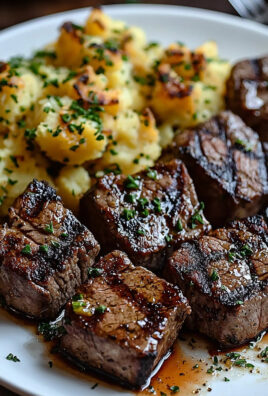Korean Beef Bowl: Prepare to embark on a culinary adventure that will tantalize your taste buds and transport you straight to the vibrant streets of Seoul! Forget takeout tonight because I’m about to share a recipe that’s not only incredibly delicious but also surprisingly easy to make at home. This isn’t just another weeknight dinner; it’s an experience.
Korean cuisine is steeped in history, with dishes often reflecting the country’s rich agricultural heritage and traditions of communal eating. While the exact origins of the modern Korean Beef Bowl are debated, its popularity is undeniable, stemming from its perfect balance of savory, sweet, and umami flavors. Think tender, marinated beef, fragrant rice, and a medley of colorful vegetables a symphony of textures and tastes in every bite!
What makes the Korean Beef Bowl so universally loved? It’s the harmonious blend of flavors, the satisfying chewiness of the beef, and the comforting warmth of the rice. Plus, it’s incredibly versatile! You can customize it with your favorite veggies, adjust the spice level to your liking, and even swap out the beef for chicken or tofu. Whether you’re a seasoned cook or a kitchen novice, this recipe is guaranteed to impress. Get ready to create a restaurant-quality meal in the comfort of your own home!
Ingredients:
- 1.5 lbs Ground Beef (80/20 is great for flavor)
- 1 medium Yellow Onion, finely chopped
- 4 cloves Garlic, minced
- 1 inch Ginger, grated
- 1/2 cup Soy Sauce (low sodium preferred)
- 1/4 cup Brown Sugar, packed
- 2 tablespoons Sesame Oil
- 1 tablespoon Rice Vinegar
- 1 teaspoon Red Pepper Flakes (adjust to your spice preference)
- 1/2 teaspoon Black Pepper
- 2 tablespoons Cornstarch
- 2 tablespoons Water
- Cooked Rice, for serving (Jasmine or short-grain are excellent choices)
- Optional Garnishes: Sesame Seeds, Green Onions (sliced), Kimchi, Gochujang (Korean chili paste), Sriracha
Preparing the Korean Beef:
- Get Started: In a large skillet or wok, heat 1 tablespoon of sesame oil over medium-high heat. Make sure the pan is nice and hot before adding the beef. This will help it brown properly.
- Brown the Beef: Add the ground beef to the hot skillet. Break it up with a spatula as it cooks. You want to brown the beef evenly. This usually takes about 5-7 minutes. Don’t overcrowd the pan; if necessary, brown the beef in batches to ensure proper browning. Overcrowding will steam the beef instead of browning it.
- Drain Excess Fat: Once the beef is browned, carefully drain off any excess grease from the skillet. This step is important for preventing the final dish from being too greasy. You can use a spoon to carefully scoop out the grease, or you can tilt the skillet and use a paper towel to absorb the grease.
- Add Aromatics: Add the chopped onion to the skillet with the browned beef. Cook for about 3-5 minutes, or until the onion becomes translucent and softened. Stir occasionally to prevent burning.
- Incorporate Garlic and Ginger: Add the minced garlic and grated ginger to the skillet. Cook for another minute, stirring constantly, until fragrant. Be careful not to burn the garlic, as it can become bitter.
Making the Korean Beef Sauce:
- Combine Sauce Ingredients: In a medium bowl, whisk together the soy sauce, brown sugar, remaining 1 tablespoon of sesame oil, rice vinegar, red pepper flakes, and black pepper. Make sure the brown sugar is fully dissolved.
- Cornstarch Slurry: In a separate small bowl, whisk together the cornstarch and water until smooth. This will create a slurry that will help thicken the sauce.
- Add Sauce to Beef: Pour the soy sauce mixture into the skillet with the beef and vegetables. Stir well to combine.
- Thicken the Sauce: Pour the cornstarch slurry into the skillet. Stir constantly until the sauce thickens. This usually takes about 1-2 minutes. The sauce should coat the back of a spoon.
- Simmer: Reduce the heat to low and let the Korean beef simmer for another 5-10 minutes, stirring occasionally. This will allow the flavors to meld together and the sauce to thicken further. Taste and adjust seasonings as needed. You might want to add a pinch more red pepper flakes for extra heat, or a touch more brown sugar for sweetness.
Serving the Korean Beef Bowls:
- Prepare the Rice: While the beef is simmering, prepare your rice according to package directions. I personally love using a rice cooker for perfectly cooked rice every time.
- Assemble the Bowls: Spoon a generous portion of cooked rice into each bowl.
- Top with Korean Beef: Top the rice with a generous serving of the Korean beef.
- Garnish (Optional): Garnish with sesame seeds, sliced green onions, kimchi, gochujang, or sriracha, if desired. These garnishes add extra flavor and texture to the bowls. I highly recommend trying at least a few of them!
- Serve Immediately: Serve the Korean beef bowls immediately and enjoy! This dish is best served hot.
Tips and Variations:
- Spice Level: Adjust the amount of red pepper flakes to your liking. If you’re sensitive to spice, start with a smaller amount and add more as needed. You can also use gochujang (Korean chili paste) for a deeper, more complex heat.
- Vegetables: Feel free to add other vegetables to the dish. Sautéed carrots, bell peppers, or zucchini would be delicious additions. Add them to the skillet along with the onions.
- Protein: While this recipe calls for ground beef, you can also use ground turkey or ground chicken. Just be sure to adjust the cooking time accordingly.
- Sweetness: If you prefer a sweeter sauce, you can add a bit more brown sugar or even a touch of honey.
- Gluten-Free: To make this recipe gluten-free, use tamari instead of soy sauce. Tamari is a gluten-free soy sauce alternative.
- Make Ahead: The Korean beef can be made ahead of time and stored in the refrigerator for up to 3 days. Reheat it in a skillet or microwave before serving.
- Freezing: You can also freeze the Korean beef for longer storage. Let it cool completely before transferring it to a freezer-safe container. It can be stored in the freezer for up to 2 months. Thaw it overnight in the refrigerator before reheating.
- Egg Topping: For an extra touch, top your Korean beef bowl with a fried egg. The runny yolk adds richness and flavor to the dish.
- Rice Options: While Jasmine and short-grain rice are great choices, you can also use brown rice or quinoa for a healthier option.
- Leftovers: Leftover Korean beef can be used in a variety of ways. Try it in lettuce wraps, tacos, or even as a topping for nachos.
Serving Suggestions:
Korean Beef Bowls are a complete meal on their own, but you can also serve them with a side of steamed vegetables or a simple salad. Here are a few ideas:
- Steamed Broccoli
- Edamame
- Cucumber Salad
- Kimchi Fried Rice (using leftover Korean beef!)
Why This Recipe Works:
This Korean Beef Bowl recipe is a winner because it’s quick, easy, and packed with flavor. The combination of soy sauce, brown sugar, sesame oil, and rice vinegar creates a delicious and savory sauce that perfectly complements the ground beef. The addition of garlic and ginger adds depth and complexity to the flavor profile. The cornstarch slurry ensures that the sauce is thick and glossy, coating the beef beautifully. And the optional garnishes allow you to customize the bowls to your liking.
The recipe is also very versatile. You can easily adjust the spice level, add different vegetables, or use a different type of protein. It’s a great way to use up leftover ingredients and create a delicious and satisfying meal.
I hope you enjoy this recipe as much as I do! It’s a family favorite in my house, and I’m sure it will become one of yours too.

Conclusion:
This Korean Beef Bowl recipe isn’t just another weeknight dinner; it’s a flavor explosion waiting to happen! The savory-sweet beef, the perfectly cooked rice, and the vibrant toppings all come together to create a truly unforgettable meal. I genuinely believe this will become a staple in your kitchen, not just because it’s incredibly delicious, but also because it’s surprisingly easy to make. Forget takeout you can have a restaurant-quality Korean Beef Bowl ready in less time than it takes to order!
Why You Absolutely Need to Try This Recipe
Seriously, what are you waiting for? The beauty of this recipe lies in its simplicity and adaptability. The marinade is quick to whip up, and the cooking process is straightforward. Even if you’re a beginner cook, you’ll find this recipe incredibly approachable. But beyond the ease of preparation, it’s the taste that will truly win you over. The combination of soy sauce, garlic, ginger, and sesame oil creates a depth of flavor that is both comforting and exciting. Plus, it’s a fantastic way to get a healthy and satisfying meal on the table quickly.
Serving Suggestions and Variations
Now, let’s talk about how you can make this Korean Beef Bowl your own! While I love serving it over fluffy white rice, you can easily substitute brown rice, quinoa, or even cauliflower rice for a healthier option. For toppings, the possibilities are endless! I highly recommend adding a fried egg for extra richness and protein. A sprinkle of sesame seeds and a drizzle of sriracha mayo are also must-haves in my book. But don’t stop there! Consider adding pickled vegetables like kimchi or cucumbers for a tangy crunch. Sliced green onions, shredded carrots, and even a dollop of gochujang (Korean chili paste) can also elevate your bowl to the next level.
Feeling adventurous? Try using different cuts of beef! While I typically use thinly sliced ribeye or sirloin, you could also use ground beef or even shredded chicken. Just adjust the cooking time accordingly. You can also experiment with different vegetables. Bell peppers, broccoli, and mushrooms would all be delicious additions. And if you’re looking for a vegetarian option, try using tofu or tempeh instead of beef. Just be sure to press the tofu well to remove excess moisture before marinating and cooking it.
Your Turn to Create!
I’m so excited for you to try this recipe and experience the deliciousness of a homemade Korean Beef Bowl. I truly believe you’ll love it as much as I do. Once you’ve made it, I’d love to hear about your experience! Did you make any modifications? What were your favorite toppings? Share your photos and comments with me I’m always looking for new ideas and inspiration. So, go ahead, grab your ingredients, and get cooking! I can’t wait to see what you create! Happy cooking! Don’t forget to rate the recipe after you try it! Your feedback helps others discover this amazing dish.
Korean Beef Bowl: Easy Recipe & Delicious Variations
Quick and easy Korean ground beef bowls with a savory-sweet sauce, perfect served over rice with your favorite garnishes.
Ingredients
- 1.5 lbs Ground Beef (80/20)
- 1 medium Yellow Onion, finely chopped
- 4 cloves Garlic, minced
- 1 inch Ginger, grated
- 1/2 cup Soy Sauce (low sodium preferred)
- 1/4 cup Brown Sugar, packed
- 2 tablespoons Sesame Oil
- 1 tablespoon Rice Vinegar
- 1 teaspoon Red Pepper Flakes (adjust to taste)
- 1/2 teaspoon Black Pepper
- 2 tablespoons Cornstarch
- 2 tablespoons Water
- Cooked Rice, for serving (Jasmine or short-grain)
- Optional Garnishes: Sesame Seeds, Green Onions (sliced), Kimchi, Gochujang (Korean chili paste), Sriracha
Instructions
- Heat 1 tablespoon of sesame oil in a large skillet or wok over medium-high heat.
- Add ground beef and break it up with a spatula. Brown evenly for 5-7 minutes. Drain excess fat.
- Add chopped onion and cook for 3-5 minutes until translucent. Add minced garlic and grated ginger; cook for 1 minute until fragrant.
- In a medium bowl, whisk together soy sauce, brown sugar, remaining 1 tablespoon of sesame oil, rice vinegar, red pepper flakes, and black pepper.
- In a small bowl, whisk together cornstarch and water until smooth.
- Pour the soy sauce mixture into the skillet with the beef and vegetables. Stir well.
- Pour the cornstarch slurry into the skillet. Stir constantly until the sauce thickens (1-2 minutes).
- Reduce heat to low and simmer for 5-10 minutes, stirring occasionally. Taste and adjust seasonings.
- Cook rice according to package directions.
- Spoon rice into bowls, top with Korean beef, and garnish as desired.
- Serve hot.
Notes
- Adjust red pepper flakes to your spice preference.
- Add other vegetables like carrots, bell peppers, or zucchini.
- Use ground turkey or chicken as a protein alternative.
- For a sweeter sauce, add more brown sugar or honey.
- Use tamari instead of soy sauce for a gluten-free option.
- Korean beef can be made ahead and stored in the refrigerator for up to 3 days or frozen for up to 2 months.
- Top with a fried egg for added richness.
- Serve with steamed broccoli, edamame, or cucumber salad.






Leave a Comment